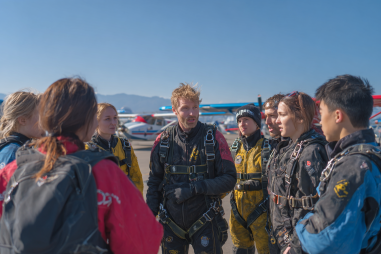Skydiving is an exhilarating sport that offers a unique rush of adrenaline and a breathtaking view of the world from thousands of feet above ground. However, beyond the thrill lies a fundamental element that every jumper must prioritize: safety. Before stepping onto that plane and leaping out into the open sky, having a comprehensive skydiving safety procedures checklist is essential. This guide is designed to walk you through the necessary steps and checks that ensure not only your safety but also the enjoyment of every jump.
Pre-jump Equipment Inspection
One of the most critical phases in skydiving safety is the thorough inspection of your gear. Before heading to the jump, it’s vital to carefully examine every piece of equipment to make sure it is in perfect working condition. This should be a methodical process where nothing is overlooked.
Start by checking your main parachute and reserve parachute. Inspect the canopy fabric for any tears or holes and ensure the lines are not tangled or frayed. Verify that the pilot chute is packed correctly, as this small chute initiates the deployment of the main parachute. Additionally, check the harness and container system for any signs of wear or damage, including the stitching and the metal hardware.
Don’t forget to examine your Automatic Activation Device (AAD), a vital safety component that deploys the reserve parachute automatically if you are unable to do so. Confirm that it’s functioning correctly and has sufficient battery life. Helmets, goggles, altimeters, and jumpsuits should also be inspected for integrity and comfort, as these contribute to your overall performance and safety during the jump.
Weather and Environmental Checks
The conditions in the sky play a significant role in the safety of your skydive. Weather can be unpredictable, and jumping under unfavorable circumstances can be hazardous.
Always review the weather forecasts, paying close attention to wind speed and direction, cloud cover, temperature, and visibility. High winds can cause instability during freefall and make landing dangerous. Low cloud coverage can obscure visibility, complicating navigation and landing. Rain or storms should be immediate grounds to delay or cancel your jump.
Additionally, analyze the drop zone conditions. Ensure that the landing area is clear of obstacles such as trees, power lines, or uneven terrain. The drop zone should be prepared and marked appropriately to facilitate a safe landing. Consulting with your drop zone supervisor or instructor about current environmental conditions is a wise practice before proceeding.
Boarding and Exit Protocols
Once all equipment and weather checks are completed, the next stage involves the boarding and exit procedures. Skydiving requires precise coordination to ensure every jumper is ready and positioned correctly.
Communicate clearly with your jumpmaster or instructor before boarding the aircraft. Confirm that your gear is secured and all safety harnesses are properly fastened. During ascent, keep your altimeter visible and continue to monitor your equipment. Pay attention to the jumpmaster’s briefing, which typically includes review of the exit order, body position for exiting the aircraft, and hand signals for communication during freefall.
At the door of the plane, maintain calm and focus. Ensure your body position aligns with instructions to ensure a smooth and safe exit. Quick and deliberate movements are necessary, but rushing can cause mistakes. Remember, a safe exit sets the tone for a successful jump.
Emergency Procedures Overview
Despite meticulous preparation, emergencies can happen in skydiving. Knowing how to handle unexpected situations is crucial for survival and injury prevention.
Familiarize yourself thoroughly with the emergency protocols before every jump. This includes knowing how to execute a cutaway if your main parachute malfunctions and how to deploy your reserve chute correctly. Practice these procedures during your training to build muscle memory.
Stay aware of your altitude at all times through your altimeter, and know the minimum deployment altitude for your parachutes. If you experience relative wind problems or other equipment malfunctions, you must act swiftly but carefully.
Also, understand signals and communication methods with your jump team and ground crew. Establishing clear communication channels can be crucial in resolving emergencies efficiently.
Post-jump Safety Steps
Landing safely is the final phase where your safety checklist continues to play an important role. After touching down, quickly but carefully gather your canopy and gear to avoid hazards like other jumpers landing nearby or environmental obstacles.
Take time to evaluate how the jump went, including your body control, parachute function, and landing execution. Communicate any equipment issues to your riggers immediately to ensure prompt maintenance. Self-assess for any physical injuries, even minor ones, and seek medical attention if necessary.
Participate in post-jump debriefings. These discussions help you and your team learn from each jump, highlighting what went well and what can be improved. This practice is integral to fostering ongoing safety and performance enhancement.
Tips for Maintaining Consistent Safety Practices
Consistency is key in skydiving safety. Building good habits and maintaining focus on safety each time you jump will dramatically reduce risks.
- Stay Educated: Keep up with training sessions, refresher courses, and new safety protocols.
- Peer Checks: Engage in buddy checks before every jump to catch potential errors you might miss yourself.
- Listen to Experts: Value the advice of experienced instructors and riggers; their insights can save lives.
- Stay Healthy: Physical and mental fitness affect your performance and response time during jumps.
- Don’t Rush: Take your time in every step, from packing to landing, avoiding haste-induced mistakes.
By embedding these habits into your skydiving routine, you develop a culture of safety that protects you and your fellow jumpers.
Making Safety a Habit
Skydiving safety is not a one-time checklist but a commitment that must be embraced with every jump. The thrill of soaring through the sky is incomparable, and that experience should never be compromised by neglecting the fundamentals of safety. By following a detailed skydiving safety procedures checklist, you take control of your jump’s outcome, mitigating risks and enhancing your enjoyment.
Every jumper, beginner or seasoned, must respect the power of preparation, awareness, and adherence to protocols. When safety becomes second nature, the skydiving adventure transforms into a confident, secure, and memorable experience. Keep these essential steps front and center, and always honor the sky’s vast possibilities with the utmost respect for safety.







